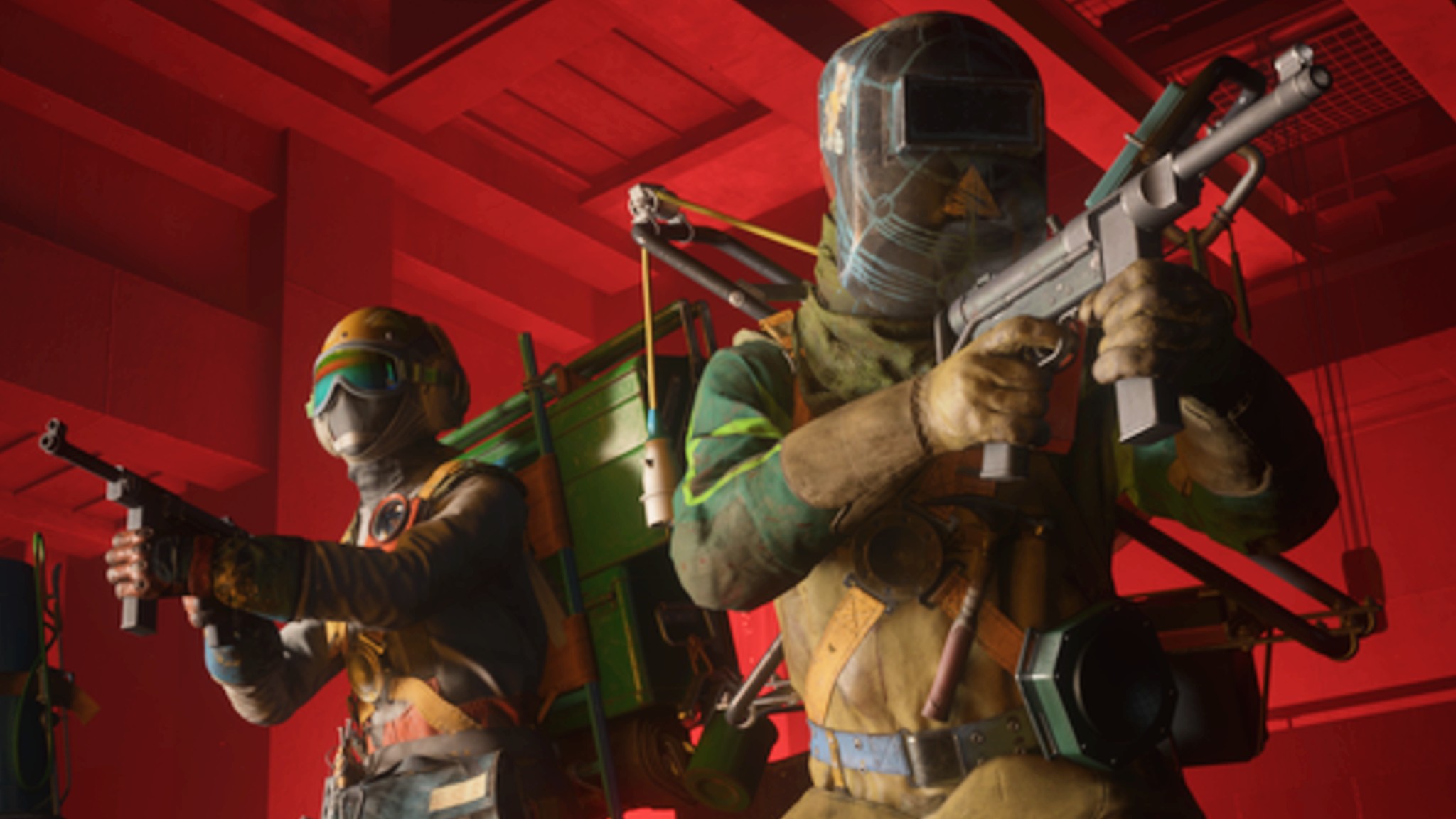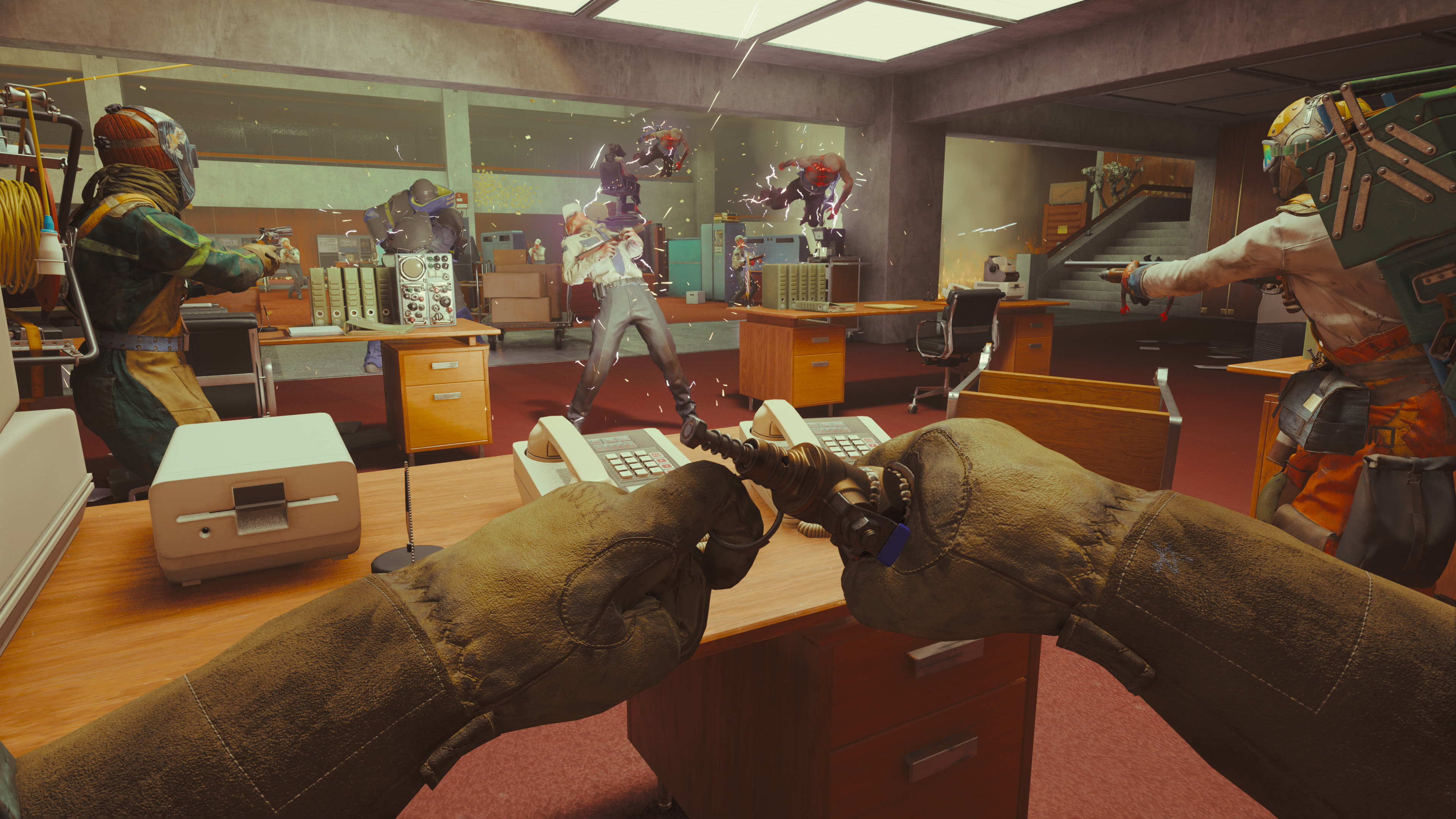
This year signifies a significant milestone for Remedy Entertainment, as they celebrate their 30th anniversary – an achievement not many video game creators or publishers manage to attain. Founded in 1995, this Finnish studio has produced some of the most original games available in the market. From the eerie presence haunting the town of Bright Falls in Alan Wake to the enigmatic Hiss lurking within the Oldest House in Control, these are among the most adored single-player titles in gaming. In a surprising departure from their traditional third-person narrative-driven shooter genre, Remedy’s upcoming game is a first-person cooperative shooter titled FBC: Firebreak.
Remedy Entertainment is sticking close to its origins, as evident in the game FBC: Firebreak, which was displayed during the Xbox Partner Preview showcase last year. This upcoming title is set six years after the events of Control and takes place within the Oldest House, where the Federal Bureau of Control remains under lockdown, preventing any personnel or objects from entering or exiting the premises. After a long struggle to vanquish the Hiss, Director Jesse Faden (the main character from Control) decides to establish the Firebreak Initiative, an organization composed of untrained volunteers who serve as first responders, tasked with managing the persistent threat that hangs over the employees of the FBC.
FBC: Firebreak Focuses on Gameplay, Not Lore

For quite some time now, Remedy Entertainment has been deeply rooted in storytelling and world creation, particularly after their release of Control. They introduced the Remedy Connected Universe (RCU) in 2019, merging the realms of Alan Wake, Control, hinting at Quantum Break, and referencing Max Payne. This unique and captivating gaming universe has been a result. So, you might wonder, how does a cooperative first-person shooter like FBC: Firebreak fit into the RCU? Although it’s part of Remedy Entertainment’s larger narrative, the emphasis is more on gameplay rather than expanding the rich lore of their universe. However, that doesn’t exclude it from having its own tales to tell; it just seems that those stories aren’t the primary focus of this specific project.
One intriguing aspect of the game FBC: Firebreak, as game director Mike Kayatta explained in a sneak peek, is that less dialogue makes it even more captivating. This means that when something is said, it carries greater weight, and players pay closer attention to every detail. The team behind the project has carefully considered numerous small details, which may not seem significant on their own, but together they make the most of the game’s space. They aim to provide what players desire without overcrowding the experience.
It’s Not a Live-Service, It’s a Session Shooter
Games such as Destiny, Fortnite, World of Warcraft, and numerous others regularly request players if they wish to explore and unlock all the game’s features on a daily basis. In essence, it’s almost akin to having an additional job, considering that completing a battle pass can consume days. Certain titles, like NBA 2K25 for example, demand so much that some individuals opt to purchase real-world currency in order to finish a season’s content.
Firebreak (FBC) by Remedy Entertainment isn’t about hopping on the live-service bandwagon. Instead, as described by Kayatta, it is categorized as a “session shooter,” which resembles games such as Left 4 Dead in that it encourages players to join and play without being overwhelmed by daily grind requirements. Furthermore, all post-launch content will be provided for free to all players, ensuring equal access to content. The only microtransactions will be for cosmetic items.

Kayatta clarifies that our commitment to supporting the game post-launch isn’t casual or haphazard. Instead, we aim to actively and vigorously back the game by creating various types of content. However, what sets us apart from many live service games is the pace at which we release updates, the intensity with which we promote them, and the way we design them to engage players effectively.
Kayatta goes on to discuss battle passes. He’s not claiming they’re inherently bad, but he points out a recurring issue: after playing for a month, players might feel like they can’t complete the pass because they didn’t invest enough time earlier, and then the next month begins! It seems like everyone is competing to create the least troublesome version of this very frustrating “Fear Of Missing Out” system. That’s what we aim to move past.
Remedy Entertainment’s Communications Director, Thomas Puha, made it clear that they take post-launch matters very seriously. While they are aware of their plans, they prefer to discuss them at a later time. They have given careful consideration to avoid using terms like ‘live service’ or ‘games as a service’, as these terms can carry high expectations.
Getting the Job Done

In the game titled “FBC: Firebreak“, participants assume the character of volunteers from the Firebreak Initiative, acting as first responders. These individuals undertake “Tasks,” which are the various missions players will engage in within the Oldest House. Each of these Tasks features a distinct setting, goal, and emergency situation to manage (similar to the sticky notes depicted in the trailer).
In this setup, you can customize these tasks by selecting a Risk and Access Limit; effectively, these function like the difficulty settings in a game. The Risk Level influences the intensity of combat challenges and the potential rewards, while the Access Limit decides the number of areas involved in the mission and the type of rewards that can be obtained. In simpler terms, these levels control the challenge level of the game and how long a gaming session might last.
As a fan, I’d rephrase that into: At the start of each adventure, I have access to three pre-set Crisis Kits, or loadouts as they’re often called. Each kit is tailored around a unique tool and playstyle, and as I get comfortable with them, I can customize them to suit my needs. If a situation calls for a different approach mid-run, I have the flexibility to switch to another Crisis Kit on the fly.
Gameplay can be tailored more specifically by incorporating Research Perks, which grant players unique enhancements for a competitive edge. These could encompass features like having a chance for stray bullets to reload automatically or the ability to leap up and put out fires on oneself if caught alight. Having two identical perks will boost their power, while carrying three of the same type will share its benefit with other Firebreakers.
This aligns perfectly with Remedy Entertainment’s approach to design, which emphasizes casual play. This means players have the freedom to tailor their experience and control how they engage with it. In essence, it’s nothing new for a cooperative shooter, as customizable difficulty and loadouts have been around since FBC: Firebreak. Yet, what makes this game stand out is its flexibility, allowing players to take on the challenge at their preferred pace.
Although Firebreak (FBC) appears standard at first glance, it carries Remedy Entertainment’s distinctive touch that sets their games apart from others. The latest trailer showcased an in-depth glimpse of the “Paper Chase” Job, demonstrating how the different mechanics harmoniously blend to form Remedy’s interpretation of a cooperative first-person shooter set within the Finnish studio.

In this specific mission, Firebreakers are assigned to eliminate troublesome sticky notes that are causing issues at the FBC. Gameplay-wise, it resembles a standard first-person shooter with movement and shooting mechanics. However, what sets it apart is the unique tools found in each Crisis Kit. At launch, there were three pre-saved kits: Splash, Jump, and Fix. The Splash kit harnesses water to heal team members, the Jump kit employs electric-powered attacks to manage a swarm of Hiss, and the Fix kit equips players with a wrench for repairing machinery and staggering enemies.
It appears that all these Kits function harmoniously together. As demonstrated in one instance, the Splash Kit’s device imparts a wet status that slows adversaries, making it easier for players using the Jump or Fix Kit to eliminate them with their specific tools. To me, this was the only gameplay that highlighted any synergy between the Kits. I hope that more such interactive properties will be prominent across each Job, as this could become one of the unique selling points of FBC: Firebreak.
In addition to its collaborative gameplay between kits, Firebreak: Firebreak also features other cooperative aspects that become evident during the demo. Towards the end of the Job’s sections, Firebreakers engage in a battle against a colossal sticky note monster. While it may appear that players can just keep shooting at it until it’s defeated, there are alternative ways to weaken the monster. For instance, one player could enter a different room and input a code to activate generators, similar to the stratagems in Helldivers 2. Once activated, a player can turn on one of the generators near the boss, causing significant damage and stunning them temporarily, making them vulnerable for a short while.
Additionally, there are instances similar to these where characters perform simple yet impactful actions, such as the Fix Kit character employing a wrench to illuminate a pitch-dark room or the Splash Kit character scrubbing sticky notes off fellow friendly players. Although it’s uncertain how this interplay will evolve based on Job-related emergencies, these collaborative instances serve as another way for Remedy Entertainment to distinguish itself in the bustling gaming genre. Given their innovative flair, it’ll be intriguing to observe how and if these kits respond differently to various crises.

The Job concludes as the Firebreakers escape from the FBC’s hallway maze filled with sticky notes. While the FBC isn’t shy about flooding a team with enemies throughout the job, it seems that this intensity is particularly heightened at the end of each mission. However, don’t fret if you fail to complete the mission during this final phase. As long as the objectives are met, the FBC considers the mission accomplished. Consequently, you will earn experience and become more adept with your chosen equipment, regardless of whether you manage to survive the Hiss attack. If you do manage to outlive the onslaught, you’ll receive any currency gathered during the mission, which can be used to buy cosmetics, gear, or upgrades.
In this setting, the Firebreak game (FBC) could offer a delightful and repeatable play experience when executed properly. Balancing risk against reward can be challenging, but when executed skillfully, it’s what keeps players coming back to a game. Some of my most memorable moments in multiplayer shooters have been during tense situations where defeat seemed imminent, such as being the sole surviving team in Fortnite or attempting to escape a planet in Helldivers 2. If Remedy Entertainment manages to replicate this thrilling experience, Firebreak could easily find a spot among players’ favorite multiplayer shooters.
It remains uncertain whether Firebreak: Firebreak will be a notable cooperative shooter when it launches this summer. However, based on previews, at the minimum, I find myself curious about what Remedy Entertainment has up their sleeve, particularly since the game seems to facilitate effortless player entry.
Read More
- Gold Rate Forecast
- PI PREDICTION. PI cryptocurrency
- Masters Toronto 2025: Everything You Need to Know
- SteelSeries reveals new Arctis Nova 3 Wireless headset series for Xbox, PlayStation, Nintendo Switch, and PC
- Mission: Impossible 8 Reveals Shocking Truth But Leaves Fans with Unanswered Questions!
- WCT PREDICTION. WCT cryptocurrency
- Guide: 18 PS5, PS4 Games You Should Buy in PS Store’s Extended Play Sale
- LPT PREDICTION. LPT cryptocurrency
- Elden Ring Nightreign Recluse guide and abilities explained
- Solo Leveling Arise Tawata Kanae Guide
2025-03-21 01:16